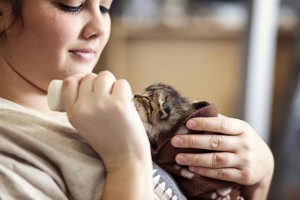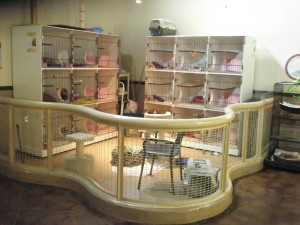Kitten nurseries are a hot topic in shelter medicine right now. As more and more shelter jump on the bandwagon it is important that we examine the pros and cons of creating your own kitten nursery and determine what is best for your shelter. Kittens season lasts from mid spring to early fall and many shelters find themselves overrun with kitten at this time. Traditionally, kittens are either euthanized or sent to foster care until they are old enough for surgery and adoption. Kittens are generally not housed in the shelter due to risk of developing illness and due to physical limitations such as sheer volume of kittens and their high requirements for basic care. Foster care has long provided free labor for cleaning, medicating, feeding and socializing kittens. Foster homes should only have one litter of kittens at a time, which means that they function as quarantine units. Sick and healthy litters are thus kept separate, which is important for reducing spread of infectious disease. Foster care also provides a home environment, to get kittens used to things such as vacuums, stairs and children. Some foster parents end up adopting kittens, or find homes for their foster kittens, which helps expedite the flow of kittens through the shelter system.
While foster care has been a staple for kitten rearing in many shelters, it does have drawbacks. Fostering hundreds of kittens means that you need a dedicated base of individuals who are available to take kittens. Some foster parents only take small numbers of kittens per year, or get burnt out due to emotional fatigue. Foster parents also have differing skill levels. Often shelters have a lack of caregivers who are comfortable–and available–to take bottle feeders or extremely sick kittens. Managing hundreds of foster caregivers is also a huge responsibility–foster coordination takes a lot of time and often requires several individuals to arrange check-ups, make calls and provide care to all the kittens in the system. For some shelters this is simply too much work, or their foster system is not yet developed enough to handle the current numbers of kittens coming through the door.
Enter the nursery. A kitten nursery is a physical location–often a room, trailer or building–which is used seasonally to house kittens. Nurseries are run by paid staff and volunteers, who provide 24 hour care to their patients, functioning much like an ICU in a veterinary hospital. Depending on the scope of the nursery, they may house bottle feeders, weaned kittens, and nursing moms in different rooms, or only provide housing for certain categories of kittens. Having 24 hour staff in short shifts means that instead of hundreds of foster care-givers waking up every 4 hours for bottle feeding, one person can feed the whole ward while the rest of the team sleeps. The nursery can be temperature controlled and all supplies are in one location. For obvious reasons, nursery staff need to be highly trained in kitten care in order to prevent milk aspiration, diarrhea and spread of contagious disease. This means that a supervisor needs to train staff and be accessible for any questions volunteers may have. Good hygiene and biosecurity is essential in nurseries in order to prevent outbreaks of diseases like panleukopenia, coccidia or ringworm. Nurseries also allow for great PR, and are a cause which many people may donate towards–perhaps those same people who didn’t donate to support the foster program or your shelter in general. That being said, nurseries can be costly to run due to increased labor time, utilities, and supplies, which are normally supplemented by the foster care-giver.
Overall, kitten nurseries are a hot new service which some shelters are providing. Foster care will remain a stable of kitten rearing in summer months, but for some shelters a nursery may be a more viable option. Knowing the pros and cons of each paradigm is essential for organizations thinking about making the switch. Remember to create protocols, consult with your veterinarian, and to provide training and support for all those involved–no matter what your kitten-saving strategy may be!
Check out the North Shore Animal Rescue League’s nursery, which includes great PR material including a live cam and information about some of the animal in their care.




Taking care for your cat or kitten is a big job. Kittens are generally not housed in the shelter due to risk of developing illness and due to physical limitations such as sheer volume of kittens and their high requirements for basic care.